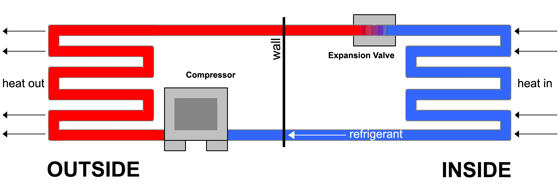9.2: Air Conditioning
- Page ID
- 47206
Now we will look at how air conditioning systems work. With air conditioning, the adjustment of humidity is important because we always try to cool warm air inside the room.
When the temperature of the air decreases, the maximum amount of water the air can hold also decreases. So the relative humidity always increases. This is more conspicuous when the room air is humid or already saturated. When the saturated air is cooled in an air conditioner, it precipitates or condenses. Water can be seen dripping outside from an AC.
Humidity is generally maintained at about 50 percent. Too low or high humidity is very uncomfortable.
Air conditioning (A/C) involves cooling/heating and cleaning of air, plus controlling its moisture level or humidity to provide maximum indoor comfort.
- An air conditioner transfers heat energy from the inside of a room, or multiple rooms in a building, to the outside.
- The air conditioner does NOT transfer air from the inside of a room, or multiple rooms in a building, to the outside.
More specifically, refrigerant in the system absorbs the excess heat from the inside and is pumped through a closed system of piping to an outside coil. A fan blows outside air over the hot coil, transferring heat from the refrigerant to the outdoor air. Because the heat is removed from the indoor air, the indoor area is cooled.
An example of a refrigerant system is shown in Figure 9.2.1.

Figure 9.2.1. Refrigerant system


